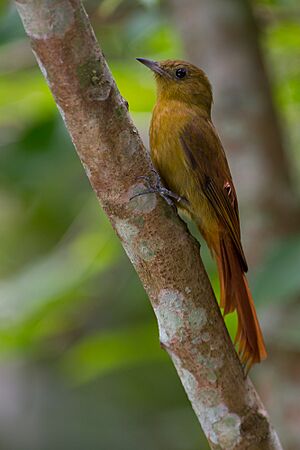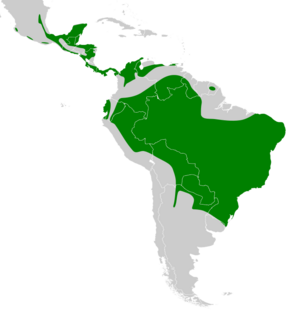Olivaceous woodcreeper facts for kids
Quick facts for kids Olivaceous woodcreeper |
|
|---|---|
 |
|
| Conservation status | |
| Scientific classification | |
| Genus: |
Sittasomus
|
| Species: |
griseicapillus
|
 |
|
The olivaceous woodcreeper (Sittasomus griseicapillus) is a small bird that lives in forests. It belongs to the ovenbird family called Furnariidae. This bird is found in many places. You can see it from central Mexico, through all of Central America, and on the island of Tobago. It also lives in most mainland South American countries.
Contents
About Its Name and Family
The olivaceous woodcreeper is the only bird in its group, called Sittasomus. However, scientists sometimes have different ideas about how to group animals. Some experts believe there are actually two different species of olivaceous woodcreepers.
Different Types of Woodcreepers
Scientists have identified 15 different types, or subspecies, of the olivaceous woodcreeper. These subspecies are often grouped into five main categories. For example, some are called "Grayish" or "Amazonian" groups.
Some bird experts, like those at BirdLife International, divide the olivaceous woodcreeper into two separate species. They call one the "eastern olivaceous woodcreeper" and the other the "western olivaceous woodcreeper." Even with these differences, most scientists agree that this bird likely has several distinct species within it.
What Does It Look Like?
The olivaceous woodcreeper is one of the smaller birds in its family. It has a slender body and a short, straight beak. Unlike many other woodcreepers, it doesn't have stripes or spots on its feathers.
Size and Color
Both male and female birds look similar in color. However, females are usually a bit smaller than males. These birds are about 13 to 19 centimeters (5 to 7.5 inches) long. Males weigh between 9 and 18 grams (0.3 to 0.6 ounces). Females are slightly lighter, weighing 8.6 to 16 grams (0.3 to 0.5 ounces). Their size and weight can change depending on where they live.
All olivaceous woodcreepers have dark eyes. Their upper beak is dark gray to black, and their lower beak is black to light gray with a dark tip. Their legs and feet can be gray, bluish-gray, or black.
Feather Colors of Subspecies
The most common type, S. g. griseicapillus, is mostly olive-colored. It has an olive-brown head and reddish-brown feathers on its lower back and tail. Its flight feathers are also reddish-brown. When it flies, you might see a yellowish-brown band on its wing.
Other types in the "Amazonian" group are similar but have small differences. For example, some are darker or grayer. Others might have more reddish-brown backs or yellowish-green undersides.
The "grayish" group subspecies are mostly olive with a contrasting brown back. Their wings and tail are reddish-brown. The "olivaceous" group birds are more olive-yellow overall. The "Pacific" type is similar to the "grayish" group but has a browner back. "Reiser's" type has a cinnamon-brown head and back.
Where Does It Live?
The olivaceous woodcreeper lives in many different places across North, Central, and South America.
Specific Locations
- S. g. jaliscensis: Lives in Mexico, north of the Isthmus of Tehuantepec.
- S. g. gracileus: Found in Mexico's Yucatan Peninsula, northern Guatemala, and northern Belize.
- S. g. sylvioides: From Mexico south of the Isthmus of Tehuantepec, through Central America, to northwestern Colombia.
- S. g. perijanus: Lives in northeastern Colombia and northwestern Venezuela.
- S. g. tachirensis: Found in northern Colombia and western Venezuela.
- S. g. griseus: Lives on Tobago and in Venezuela's eastern Andes mountains.
- S. g. aequatorialis: Found along the Pacific coast from western Ecuador to northwestern Peru.
- S. g. amazonus: Lives in the western Amazon Basin, including parts of Colombia, Venezuela, Ecuador, Peru, and western Brazil.
- S. g. axillaris: Found in the northeastern Amazon Basin, from southwestern Venezuela to Guyana and south into Brazil.
- S. g. viridis: Lives in the Amazon Basin in Bolivia.
- S. g. transitivus: Found in Amazonian Brazil, south of the Amazon River.
- S. g. griseicapillus: Lives in southeastern Bolivia, central Brazil, Paraguay, and north-central Argentina.
- S. g. reiseri: Found in northeastern Brazil.
- S. g. olivaceus: Lives in southeastern Bahia state in eastern Brazil.
- S. g. sylviellus: Found in southeastern and southern Brazil, southeastern Paraguay, and northeastern Argentina and Uruguay.
Preferred Homes
This bird lives in many types of wooded areas. It likes mature forests, but also lives in younger forests and tree plantations. Its habitats include rainforests, cloud forests, and forests along rivers. In drier areas, it can be found in scrublands and savannas. It has also been seen in bamboo stands, pine forests, mangrove swamps, coffee farms, and even city parks.
The olivaceous woodcreeper lives at different heights above sea level. In Central America, it lives from sea level up to about 1,950 meters (6,400 feet). In other areas, it can be found as high as 2,300 meters (7,500 feet).
Behavior
Movement
The olivaceous woodcreeper stays in the same area all year long. It does not migrate to different places.
Feeding Habits
The olivaceous woodcreeper mainly eats arthropods, which are creatures like insects and spiders. It also eats seeds, fruit, and small animals. In many places, beetles (both adults and larvae) are a big part of its diet. In other areas, ants are its most common food.
This bird finds food by climbing up tree trunks and along branches and vines. It usually forages in the middle and upper parts of the forest, but sometimes it searches closer to the ground. In some regions, it follows swarms of army ants to catch insects that the ants stir up. It often forages alone or in pairs. It also frequently joins groups of different bird species that are feeding together.
Reproduction and Life Cycle
The breeding season for the olivaceous woodcreeper changes depending on the location. In Central America, it's from mid-March to June. In southern Amazonia, it's between August and October.
This bird nests in holes, either natural ones or old woodpecker nests. It does not dig its own nest holes. Very few nests have been studied. One nest in Costa Rica was lined with dead leaves. The female usually lays two or three eggs. It seems that the female does most of the incubating and caring for the young. However, both parents have been seen feeding the chicks. The exact time it takes for eggs to hatch or for chicks to leave the nest is not yet known.
Vocalization
The songs of the olivaceous woodcreeper vary a lot among its different types. There are at least six main song types, which can be put into two groups. Birds in Central America and northern South America make a fast, sharp trill or thin rattling sound. Birds in the Amazon and eastern Brazil make a rapid series of clear whistles that go up and down in pitch.
For example, one type's song is described as a fast, rolling, musical trill. Another type's song is a series of notes that get higher and louder. In northeastern Brazil, the song is a high, fast, slightly rising sound. In southeastern Brazil, it's a very high, loud, descending sound.
Conservation Status
The International Union for Conservation of Nature (IUCN) considers both the "eastern" and "western" olivaceous woodcreepers to be of "Least Concern." This means they are not currently at high risk of disappearing.
Both types of woodcreepers live in very large areas. While their exact population numbers are not known, scientists believe their populations might be decreasing. No immediate major threats to these birds have been found. Some studies suggest that breaking up forests into smaller pieces might harm the woodcreeper populations. However, other studies have shown that their numbers can sometimes increase after forests are broken up.


